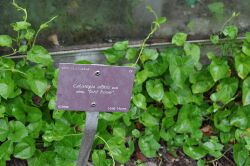Biology:Calystegia affinis
| Calystegia affinis | |
|---|---|

| |
| Scientific classification | |
| Kingdom: | Plantae |
| Clade: | Tracheophytes |
| Clade: | Angiosperms |
| Clade: | Eudicots |
| Clade: | Asterids |
| Order: | Solanales |
| Family: | Convolvulaceae |
| Genus: | Calystegia |
| Species: | C. affinis
|
| Binomial name | |
| Calystegia affinis Endl.[1]
| |
| Synonyms | |
|
Convolvulus affinis (Endl.) Maiden nom. illeg. Convolvulus marginatus (R.Br.) Spreng. nom. illeg. Calystegia marginata R.Br. (misapplication) | |
Calystegia affinis is a critically endangered species of climbing or creeping vine in the plant family Convolvulaceae.[2] It is endemic to Lord Howe Island and Norfolk Island.[2] In 2003 only about 45 mature plants were known, with about 40 of those on Norfolk Island.[3][4]
Etymology
The genus name, Calystegia is derived from the Greek: kalux, "cup", and stegos, "a covering", meaning "a covering cup" and refers to the bracteoles enclosing the calyx. The specific epithet, affinis, is Latin for 'neighbouring',[5] which was possibly chosen by Endlicher on the basis of his comment that the species was closely allied to Calystegia marginata.[6]
Description
Calystegia affinis is a thin-stemmed plant in the genus Calystegia which climbs by twining. It has sparse alternate, arrow-headed leaves about 6 cm x 5 cm.[2] The flowers are axillary,[7] solitary, pink with five[7] cream longitudinal bands and are funnel-shaped.[2] They have large persistent bracteoles enclosing the calyx which has five sepals and five petals.[7] The fruit is a papery capsule[2] which splits longitudinally into four valves.[7] The plant is thought to reproduce both clonally and by seed.[2]
Taxonomy
Calystegia affinis was first described by Endlicher in 1833.[8][6] In 1904, Joseph Maiden renamed it Convolvulus affinis,[9] but this is considered an illegal name by the Commonwealth Heads of Australian Herbaria.[8] The other synonyms[8] (given above) are illegal names, misapplications or pro-parte misapplications, with the species concept having been refined by P.S. Green in 1994 in Flora of Australia.[10]
References
- ↑ "Convolvulaceae Calystegia affinis Endl., The International Plant Name Index". https://biodiversity.org.au/nsl/services/name/apni/103196/api/apni-format. Retrieved 24 April 2018.
- ↑ 2.0 2.1 2.2 2.3 2.4 2.5 "NSW Office of Heritage and Environment, Save our Species: Calystegia affinis". http://www.environment.nsw.gov.au/determinations/CalystegiaAffinisATwiningPlantEndSpListing.htm. Retrieved 2018-03-16.
- ↑ "Calystegia affinis (a twining plant) - endangered species listing". http://www.environment.nsw.gov.au/determinations/CalystegiaAffinisATwiningPlantEndSpListing.htm.
- ↑ Coyne, Peter. Norfolk Island's Fascinating Flora. Petaurus Press, 2011, p. 61
- ↑ Stearn, W.T. (1992) 'Botanical Latin : history, grammar, syntax, terminology and vocabulary. (p. 265)' (Portland, OR. Timber Press)
- ↑ 6.0 6.1 Endlicher, S. (1833) "Prodromus Florae Norfolkicae: 51.". https://biodiversitylibrary.org/page/6140275. Retrieved 24 April 2018.
- ↑ 7.0 7.1 7.2 7.3 "PlantNET: Calystegia., National Herbarium of NSW, Royal Botanic Gardens, Sydney Australia". http://plantnet.rbgsyd.nsw.gov.au/cgi-bin/NSWfl.pl?page=nswfl&lvl=gn&name=Calystegia. Retrieved 25 April 2018.
- ↑ 8.0 8.1 8.2 "Convolvulaceae Calystegia affinis Endl., The International Plant Name Index". http://www.ipni.org/ipni/idPlantNameSearch.do?id=265641-1. Retrieved 24 April 2018.
- ↑ Maiden, J.H. (1904), The Flora of Norfolk Island. Part i. Proceedings of the Linnean Society of New South Wales 28(4): 711
- ↑ Green, P.S. in Wilson, A.J.G. (ed.) (1994), Norfolk Island & Lord Howe Island. Flora of Australia 49: 308-309, Fig. 82
Wikidata ☰ Q5024761 entry
 |


